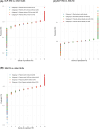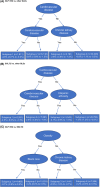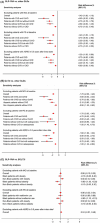Heterogeneous treatment effects of GLP-1RAs and SGLT2is on risk of Alzheimer's disease and related dementia in patients with type 2 diabetes: Insights from a real-world target trial emulation
- PMID: 40448382
- PMCID: PMC12125485
- DOI: 10.1002/alz.70313
Heterogeneous treatment effects of GLP-1RAs and SGLT2is on risk of Alzheimer's disease and related dementia in patients with type 2 diabetes: Insights from a real-world target trial emulation
Abstract
Introduction: This study assessed the heterogeneous treatment effects (HTEs) of glucagon-like peptide-1 receptor agonists (GLP-1RAs) and sodium-glucose cotransporter-2 inhibitors (SGLT2is) on the risk of Alzheimer's disease and related dementias (ADRD).
Methods: This target trial emulation study included adults (≥ 50 years) with type 2 diabetes (T2D) and newly prescribed a GLP-1RA, SGLT2i, or other second-line glucose-lowering drugs (GLDs). A doubly robust learning approach was deployed to estimate the risk difference (RD) of ADRD and identify key subgroups.
Results: Both GLP-1RAs (RD, -1.5%) and SGLT2is (-1.7%) were associated with a reduced ADRD risk compared to other GLDs. Key subgroups were determined based on cardiovascular disease (CVD), cerebrovascular disease (CeVD), chronic kidney disease, and Hispanic ethnicity. Patients with CVD and CeVD had the greatest benefits from GLP-1RAs (-4.8%) and SGLT2is (-4.6%). No overall difference was observed between GLP-1RAs and SGLT2i.
Discussion: These findings suggest the importance of personalized treatment in diabetes management regarding ADRD risk.
Highlights: Glucagon-like peptide-1 receptor agonists (GLP-1RAs) were associated with a decreased risk of Alzheimer's disease and related dementias (ADRD), while the protective association varied across subgroups defined by cardiovascular disease (CVD), cerebrovascular disease (CeVD), and chronic kidney disease (CKD). Similarly, sodium-glucose cotransporter-2 inhibitors (SGLT2is) were associated with a decreased risk of ADRD, with the protective association varying among subgroups defined by CVD, CeVD, and Hispanic ethnicity. There was no difference between GLP-1RAs and SGLT2is in the risk of ADRD.
Keywords: Alzheimer's disease and related dementias; GLP‐1RAs; SGLT2is; type 2 diabetes.
© 2025 The Author(s). Alzheimer's & Dementia published by Wiley Periodicals LLC on behalf of Alzheimer's Association.
Conflict of interest statement
The authors declare no conflicts of interest. Author disclosures are available in the Supporting Information.
Figures



References
-
- Heerspink HJL, Perkins BA, Fitchett DH, Husain M, Cherney DZI. Sodium glucose cotransporter 2 inhibitors in the treatment of diabetes mellitus: cardiovascular and kidney effects, potential mechanisms, and clinical applications. Circulation. 2016;134(10):752‐772. doi:10.1161/CIRCULATIONAHA.116.021887 - DOI - PubMed
MeSH terms
Substances
Grants and funding
- 2023PDVH1064032/The Pharmaceutical Research and Manufacturers of America (PhRMA) Foundation Predoctoral Fellowship
- R01AG089445/National Institutes of Health (NIH)/National Institute on Aging (NIA)
- R01AG076234/National Institutes of Health (NIH)/National Institute on Aging (NIA)
- R01DK133465/NIH/National Institute of Diabetes and Digestive and Kidney Diseases (NIDDK)
LinkOut - more resources
Full Text Sources
Medical
Miscellaneous

